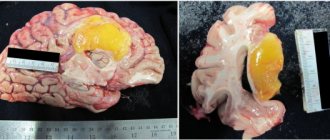What is the hypotonic type of VSD and what are its key features?
Vegetative-vascular dystonia of the hypotonic type occurs in people in whom the action of the parasympathetic nervous system predominates. They are characterized by low blood pressure and vascular tone. As a result, blood circulation is disrupted and organs do not receive the required amount of oxygen and other nutrients. This situation leads to hypoxia, blood stagnation and poor functioning of organs, in particular the brain. This is manifested by many signs that, although not dangerous to human health, are very unpleasant and worsen the patient’s quality of life. Possible causes of the hypotonic type of VSD disorder:
- hereditary predisposition (usually transmitted through the female line);
- hormonal disorders;
- chronic foci of infection or other diseases;
- bad habits;
- traumatic brain injury, concussion;
- chronic stress;
- poor nutrition;
- pregnancy;
- sedentary lifestyle;
- the influence of vibration, ionizing radiation, high temperatures, industrial poisons.
.
The pathogenesis of this dysfunction is based on low adaptation to stressful situations with functional impairment of organs and systems.
Leading syndromes of the disease:
- cardialgic (pain in the heart);
- hypotensive;
- arrhythmic;
- respiratory disorders;
- angiocerebral (associated with hypoperfusion - poor blood supply to the brain and low intracranial pressure);
- dyspepsia;
- thermoregulatory disorders;
- asthenic.
Reasons for the development of hypotonic VSD
The main reasons for the development of hypotonic VSD are:
- Genetic predisposition (mainly transmitted through the female line).
- Hormonal imbalances.
- Infections.
- Chronic diseases.
- Bad habits.
- Toxic substances.
- Traumatic brain injuries.
- Brain concussion.
- Chronic stress.
- Lack of balanced nutrition.
- Sedentary lifestyle.
The main reason for the development of VSD is a hereditary factor, which manifests itself mainly in women. The occurrence of vegetative syndrome is associated with hormonal disorders, increased emotionality, and regular experiences due to stressful situations.
VSD hypotonic type of cause
The hypotonic type of VSD occurs in people with low or normal body weight. There is low performance, a constant feeling of fatigue, weakness, and pale skin. The reason for such manifestations is a lack of energy resources, which are wasted over time and lead to depletion of the nervous system. As a result, symptoms of various diseases develop.
Neuropsychic stress is also a provoking factor in the development of VSD of the hypotonic type. When stressful situations occur, the sympathetic and parasympathetic departments must function naturally. At the same time, the sympathetic part of the nervous system is activated, the heart rate increases, and the body turns on protective reactions to combat negative conditions. The parasympathetic department controls the processes of the basic functions of the body. During regular stressful situations, the sympathetic nervous system predominates in the body, causing the development of VSD.
What are the main symptoms of vegetative-vascular dystonia of the hypotonic type?
Symptoms of VSD of the hypotonic type:
- headache;
- fast fatiguability;
- decreased blood pressure (hypotension): below 100/60 mmHg, more often during physical or emotional stress;
- dizziness;
- anxiety;
- fainting;
- irritability;
- pain or discomfort in the body;
- sleep disturbance;
- heartache;
nausea;- diarrhea;
- heartburn;
- difficulty breathing (feeling of lack of air, insufficient inhalation);
- skin redness;
- arrhythmia;
- apathy (extrasystole);
- poor appetite;
- decrease in heart rate;
- increased skin moisture;
- decreased concentration.
How to determine the type of VSD?
Vegetative-vascular dystonia is one of the most difficult pathologies to diagnose and treat. What type of VSD do you have?
Symptoms of VSD may differ in different cases, and this is due to the fact that different types of dystonia can disrupt the functions of different systems.
There is no generally accepted classification system for vegetative-vascular dystonia today. Some of these systems are quite difficult to understand and are used only for scientific purposes. Most often, doctors use a classification where the main criterion is blood pressure parameters.
Cardiac type (normosthenic)
This type of VSD is characterized by normal blood pressure. The main symptoms are related to sensations in the heart and psychological reactions. The attacks are accompanied by a feeling of lack of air, palpitations, interruptions in heart function, a feeling of rhythm disturbances, panic, fear of death, and heart pain. Characteristic signs are weather dependence, headaches when overworked, adrenaline surges, and a tendency to depression.
VSD of hypotonic type
The main characteristic of the hypotensive type of VSD is pressure that is low relative to normal, as well as an even greater decrease during periods of attacks. Corresponding symptoms are dizziness, orthostatic collapse, poor tolerance to hunger, “hunger” headaches, pallor, cold feet and hands even in warm weather. A tendency to asthenia is often observed already in childhood. Characteristic psychological symptoms are a tendency towards hypochondria, increased anxiety.
VSD of the hypertensive type
Typically, these people's blood pressure is normal or slightly elevated. Physical activity, psychological stress, fatigue, the need for acclimatization, and alcohol intake can cause an increase in systolic pressure to values above 140 mmHg. In this case, there may be unpleasant, squeezing sensations in the area of the heart and chest, and a feeling of a squeezing hoop on the head. For a long time, no organic disorders that are characteristic of hypertension are observed.
What type of VSD might you have?
Each type of VSD is rare in isolation. Usually the cardiac type is combined with hypertensive or hypotensive. Over time, the hypotensive type can be replaced by a hypertensive one, with the transition to hypertension.
There are also other divisions, for example into syndromes, which indicate a leading system that determines the main group of symptoms. But for the treatment of VSD it is convenient to use the above classification.
Treatment of dystonia, depending on the type, differs in the recommended daily regimen and features of assistance during the period of severe symptoms. The main drug prescribed for all types of VSD is Eltacin® . This is a complex of three amino acids - cystine, glutamic acid and glycine - which activate cellular respiration and act directly on the cause of vegetative-vascular dystonia, regardless of its type.
Constant use of Eltacin® helps to normalize the condition of dystonia of any type.
Is it worth using additional diagnostics to make a diagnosis?
To confirm VSD of the hypotonic type, additional diagnostic methods are used. This is necessary in order to exclude other diseases with similar manifestations. And only if the examination results are within normal limits, or the deviations are actually characteristic of vegetative-vascular dystonia, can this diagnosis be made.
Examination methods and their results:
- General blood test: no changes.
- Biochemical blood test: normal.
- Electrocardiography: sinus bradycardia, extrasystole, negative T wave.
- Test with hyperventilation: 30-45 s the patient takes deep breaths and exhales; after this, an electrocardiogram (ECG) is recorded and compared with that recorded before the test. The test is positive if the heart rate (pulse) has increased by 50-100% of the original value or the T wave has become negative (mainly in the chest leads).
- Orthostatic test:
- An ECG is recorded while lying down;
- then the patient stands for 10-15 minutes and the electrocardiogram is taken again;
- a positive result is recognized if the pulse increases and the T waves become negative (usually in the chest leads).
- Potassium test:
- registration of the initial ECG in the morning, on an empty stomach;
taking 6-8 g of potassium chloride in 50 ml of juice or unsweetened tea;
- a repeat electrocardiogram is taken after 40 minutes and 1.5 hours;
- The result will indicate VSD when the initial negative or reduced T became positive.
- Beta blocker test:
- initial ECG recording;
- taking 60-80 mg of obzidan (anaprilin) in tablets;
- repeat electrocardiogram after 60-90 minutes;
- The result of the study in a patient with VSD: ST depression disappears, negative or low T levels become positive.
- Bicycle ergometry results:
- decreased performance and exercise tolerance;
- an increase in heart rate by more than 50% of the original;
- prolonged tachycardia (frequent heartbeat), the rhythm is restored only after 20-30 minutes;
- the appearance of a deep S wave in the first lead and Q wave in the third;
- deviation of the electrical axis to the right;
- normalization of the T wave;
- short-term shift of ST below the isoline by no more than 1 mm.
These changes are very similar to those in coronary heart disease. But the difference is that with VSD they do not occur at the height of the load, but during rest.
- Phonocardiography: additional tone in systole and not pronounced systolic murmur.
- Echocardiography: no changes. Some patients experience mitral valve prolapse.
- X-ray examination of the chest organs: no changes.
- Spirography: some patients experience an increase in minute respiratory volume.
- Measuring body temperature.
- Measurement of blood pressure (BP) in both arms and legs.
- 24-hour blood pressure monitoring (Holter blood pressure).
- 24-hour electrocardiogram monitoring (Holter-ECG).
- Consultation with an otolaryngologist, neurologist, psychotherapist.
Symptoms of pathology of the hypotonic type
The pathological syndrome has many manifestations, which may bother one patient completely, while another will experience only a few characteristic symptoms. With dystonia of the hypotensive type, disturbances occur in almost all internal organs, so the pathology affects the general condition of the patient.
| System | Pathological manifestations |
| Cardiovascular |
|
| Nervous |
|
| Digestive |
|
Other signs of VSD
Often hypotonic dystonia provokes respiratory system disorders. The person feels short of breath, cannot take a deep breath, and there is a lack of air. A person with hypotonic VSD feels constant fatigue, apathy, and indifference to everything. The following general patient complaints are noted:
- A large amount of sweat is produced, especially in the palms and soles.
- There may be a slight or strong increase in body temperature, at which a chilling sensation is possible.
- The functioning of the organs of the genitourinary system is disrupted, as a result of which it is painful for a person to empty the bladder. In addition, women with VSD suffer from vaginismus, and it becomes more difficult for them to achieve orgasm. In men, sexual function also suffers: erection is impaired and ejaculation weakens.
How can the disease be effectively treated?
The principles according to which it is necessary to treat VSD of the hypotonic type:
Etiotropic therapy: treatment of foci of chronic infection, hormonal disorders, elimination of the influence of harmful occupational factors and intoxications; eliminating bad habits (smoking, drinking alcohol).- Increase physical activity.
- Balanced diet.
- Normalization of sleep and rest patterns.
- Reducing body weight if it is excessive.
- Limit salt and saturated fat intake from meals.
If the above measures do not eliminate the symptomatic manifestations, doctors resort to prescribing medications :
- Drug treatment: sedative therapy - herbal medicine (valerian, hawthorn, St. John's wort, wormwood, peppermint, dog nettle); tranquilizers (Diazepam, Phenazepam, Mebicar, Phenibut, Oksidin, Amizil). If recommended by a psychotherapist, antidepressants.
- If necessary: adaptogens (ginseng, eleutherococcus), B vitamins, nootropics (nootropil, piracetam), drugs with metabolic effects (trimetazidine, mildronate).
- Reflexology: acupuncture, magnetic reflexotherapy.
- Physiotherapeutic procedures aimed at activating the sympathetic nervous system: paraffin, ozokerite, pine and salt baths, contrast shower.
- Active massage at a fast pace.
Main causes of VSD
- Vegetative-vascular dystonia can be provoked by a hereditary factor, in which the pathology is transmitted from close blood relatives. Mostly hypotonic VSD is transmitted through the female line.
- Another common cause of the development of VSD with hypotension is the influence of bad habits (alcohol, smoking).
- Constant stressful situations and overexertion are the main factors that lead to this type of VSD. When a person has an abnormal regime, the brain areas responsible for the functioning of the heart and central nervous system malfunction.
- Often, vegetative-vascular dystonia of the hypotensive type manifests itself as a result of traumatic brain injury or concussions.
- The presence of infectious or chronic pathologies increases the risk of developing VSD of the hypotonic type. In this case, the human immune system weakens, which leads to depletion of cardiac function and a decrease in blood pressure.
- Hormonal imbalance, which more often manifests itself in women, becomes the impetus for the development of hypotonic VSD. The pathology is often observed in women during menopause, when carrying a child, and adolescents are also at risk.










